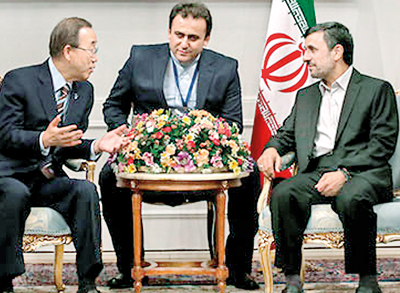Sunday Times 2
NAM in Teheran: Only power and influence matter
NEW DELHI – Nowadays, the Non-Aligned Movement (NAM) is no longer much of a movement. Since the Cold War’s end, it has fractured into a far more heterodox grouping whose members range from leftist regimes, as in Cuba, North Korea, and Venezuela, to the conservative monarchies (Saudi Arabia, Bahrain, Qatar) of the Persian Gulf. So it should be no surprise that ideological cacophony has severely diluted the group’s founding impulse of avoiding entanglement in the disputes of the world’s superpowers.

UN Secretary General Ban Ki-moon speaks with Iran's president Mahmoud Ahmadinejad upon arrival in Tehran for the NAM summit. Photograph: Reuters
Thus, today’s NAM finds itself as a group in search of purpose and principle. Its sole comfort, it seems, is that it has not yet withered away.
But, despite its diminished status, the recent NAM summit in Tehran was able to claim the world’s attention. Why hold the summit in Teheran, some members asked? This, however, only raised heckles from those who still see the group as a means to stare down the superpowers. Their retort – “Why not in Tehran?” – angered more than it soothed.
The dispute over the wisdom of holding the summit in Iran’s capital revived the core debate about what “non-aligned” means in the post-Cold War world. Why keep such an anachronistic construct alive when the world is no longer frozen into two ideologically antagonistic blocs? Furthermore, given the proliferation of strategic partnerships that claim many NAM members (India, for example, has strategic partnerships with the United States, Japan, and Brazil), are the non-aligned really still non-aligned?
To this, the movement’s defenders ask: “Why persist with NATO and expand it ever eastward, until its troops now sit almost on the banks of the Indus, and in the foothills of the Hindu Kush?” The Cold War has ended, they argue, but that only means that the world is divided in many more ways than before. So maintaining NAM is not some nostalgic longing for an influential past; rather, it is a means for countries to maintain as much international influence as possible in our globalized world.
But how can NAM help its members when nothing else unites them? According to Kanwal Sibal, a former head of India’s foreign service, “India’s own experience of NAM in areas of its core national interest has been most unsatisfactory, which is enough reason to shed any undue sentimental or ideological attachment to the movement.”
Indeed, as Sibal points out, NAM did not protect India from decades of “US/Western technology-related sanctions,” even when it was the movement’s leader. Likewise, “in the 1962 conflict with China, NAM did not back India’s position.” The same is true, Sibal continues, of Kashmir and India’s nuclear tests. As a result, India, he argues, owes NAM’s other members nothing, and should act only according to what is “best for its own interests.”
And yet India, like so many other countries, maintains its NAM membership, because NAM does provide an additional platform, which India needs and treats as one tool among others in its diplomatic toolkit. Occasionally, NAM provides a useful counterweight to Western pressure – say, regarding Iran, with which India remains eager to build trade and energy relationships.
So, to be blunt, NAM survives because of America’s recent global domination and its efforts to impose its policies globally. And, with a rising China seeking to do much the same in its immediate neighborhood (and perhaps farther afield in the future), the movement has a second reason for surviving as a check on the super-powerful.
In a recent article, Ashley Tellis of the Carnegie Endowment for International Peace bemoans that, “India’s foreign-policy establishment is in the process of disinterring a long-dead grand strategy from its Cold War grave.” He cites a recent report, “Nonalignment 2.0,” that promotes non-alignment – a “doctrine that calls upon India to refuse staunchly any strategic alliances with other actors” – in order to ensure the country’s “strategic autonomy.”
At first glance, nonalignment looks like an attractive option for still-emerging countries like India, Indonesia, Brazil, and others, because it promises freedom from the insidious grip of entangling alliances. But, more important, it holds out the prospect that a people can chart its own path, free from external pressure – a particularly attractive proposition for countries that remain scarred by their colonial pasts.
But how can these impulses be reconciled with the strategic partnerships that India, Brazil, and others are currently forming, or with those – like the US-Saudi relationship – that have lasted for decades? The answer is simple: International order does not adhere to a logically consistent code. In the harsh light of realpolitik, only power and influence matter. If NAM enhances a country’s power and influence, it will maintain its membership.
Of course, the bothersome aspect of NAM’s Teheran summit is that Iran will head the movement for the next three years. But that could well divide NAM even further: Egyptian President Mohammed Mursi, invited to sit next to Iran’s leadership, used the occasion to denounce publicly his hosts’ policy in Syria.
India’s participation in the Teheran summit should not strain its ties with the US. Just because the US continues to pursue its sterile policy of not speaking with Iran, India – with its own strategic, geopolitical, and energy-related interests to protect – does not need to tag along. Neither strategic partnership with the US, nor membership in NAM, will divert India from safeguarding those interests.
Jaswant Singh, a former Indian finance minister, foreign minister, and defense minister, is the author of Jinnah: India – Partition – Independence. Copyright: Project Syndicate, 2012. Exclusive to the Sunday Times
Follow @timesonlinelk
comments powered by Disqus























